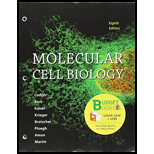
Concept explainers
To write:
The ligand having a higher affinity for receptor 1 or receptor 2. Given data is Kd value of receptor 1 is 10-7 M and 10-9 M for receptor 2. The calculated fraction of receptors which contain a ligand ([RL]/RT) in the case of receptor 1 and receptor 2. The concentration of free ligand is 10-8 M.
Introduction:
In biochemistry, Kd denotes the dissociation equilibrium constant. It represents a type of equilibrium constant. It usually measures the tendency of the complex molecule dissociation into its sub-components. It also defines the strength of a ligand bound to a protein.
Explanation of Solution
In biochemistry, Kd denotes the dissociation equilibrium constant. It represents a type of equilibrium constant. It usually measures the tendency of the complex molecule dissociation into its sub-components. It also defines the strength of a ligand bound to a protein. Smaller the dissociation constant, higher will be the affinity of the ligand to bind more tightly with the receptor protein. The ligand will tend to bind more strongly with receptor 2 as the Kd value for this reaction is much less 10-9M. While in the case of receptor 1, the Kd value is higher. Thus, the ligand shows a higher affinity for receptor 2.
This can be proved in the following mathematical steps on the basis of the fraction of receptors.
The total amount of receptor can be expressed as the sum of the concentrations of free ([R]) and bound [RL] receptor.
By putting these values of [RL] in equation 1
When both numerator and & denominator are multiplied by Kd. Then,the following form of equation is obtained.
According to the question
From the mathematical equation and calculations, we get the values of fractions for receptor 1 and receptor 2 as 0.090 and 0.90 respectively. For this present situation, receptor 2 has a high fractional value which means there is a large amount of ligand-receptor 2 complexes as compared to ligand-receptor 1 complex.
This proves that the receptor 2 with Kd (10-9M) will show the greater affinity for the ligand. The reason is that smaller the dissociation constant, higher affinity or more tightly ligand binding between the protein and ligand will be there. This present situation shows that most of the ligands are bound to the proteins (receptor 2).
Thus, the ligand shows a higher affinity for receptor 2. This present situation means that maximum ligands are bound to the receptor 2.
Want to see more full solutions like this?
Chapter 15 Solutions
Loose-Leaf Version for Molecular Cell Biology & LaunchPad for Molecular Cell Biology (6 month access)
 Human Anatomy & Physiology (11th Edition)BiologyISBN:9780134580999Author:Elaine N. Marieb, Katja N. HoehnPublisher:PEARSON
Human Anatomy & Physiology (11th Edition)BiologyISBN:9780134580999Author:Elaine N. Marieb, Katja N. HoehnPublisher:PEARSON Biology 2eBiologyISBN:9781947172517Author:Matthew Douglas, Jung Choi, Mary Ann ClarkPublisher:OpenStax
Biology 2eBiologyISBN:9781947172517Author:Matthew Douglas, Jung Choi, Mary Ann ClarkPublisher:OpenStax Anatomy & PhysiologyBiologyISBN:9781259398629Author:McKinley, Michael P., O'loughlin, Valerie Dean, Bidle, Theresa StouterPublisher:Mcgraw Hill Education,
Anatomy & PhysiologyBiologyISBN:9781259398629Author:McKinley, Michael P., O'loughlin, Valerie Dean, Bidle, Theresa StouterPublisher:Mcgraw Hill Education, Molecular Biology of the Cell (Sixth Edition)BiologyISBN:9780815344322Author:Bruce Alberts, Alexander D. Johnson, Julian Lewis, David Morgan, Martin Raff, Keith Roberts, Peter WalterPublisher:W. W. Norton & Company
Molecular Biology of the Cell (Sixth Edition)BiologyISBN:9780815344322Author:Bruce Alberts, Alexander D. Johnson, Julian Lewis, David Morgan, Martin Raff, Keith Roberts, Peter WalterPublisher:W. W. Norton & Company Laboratory Manual For Human Anatomy & PhysiologyBiologyISBN:9781260159363Author:Martin, Terry R., Prentice-craver, CynthiaPublisher:McGraw-Hill Publishing Co.
Laboratory Manual For Human Anatomy & PhysiologyBiologyISBN:9781260159363Author:Martin, Terry R., Prentice-craver, CynthiaPublisher:McGraw-Hill Publishing Co. Inquiry Into Life (16th Edition)BiologyISBN:9781260231700Author:Sylvia S. Mader, Michael WindelspechtPublisher:McGraw Hill Education
Inquiry Into Life (16th Edition)BiologyISBN:9781260231700Author:Sylvia S. Mader, Michael WindelspechtPublisher:McGraw Hill Education





